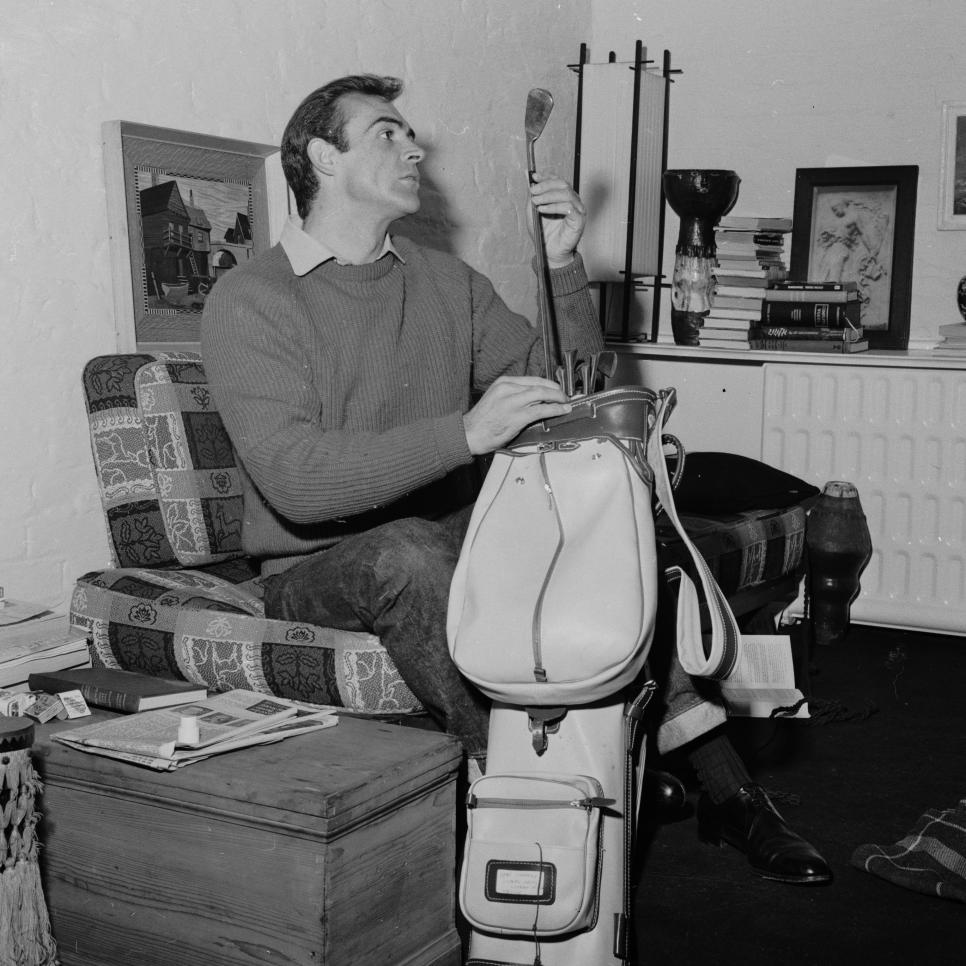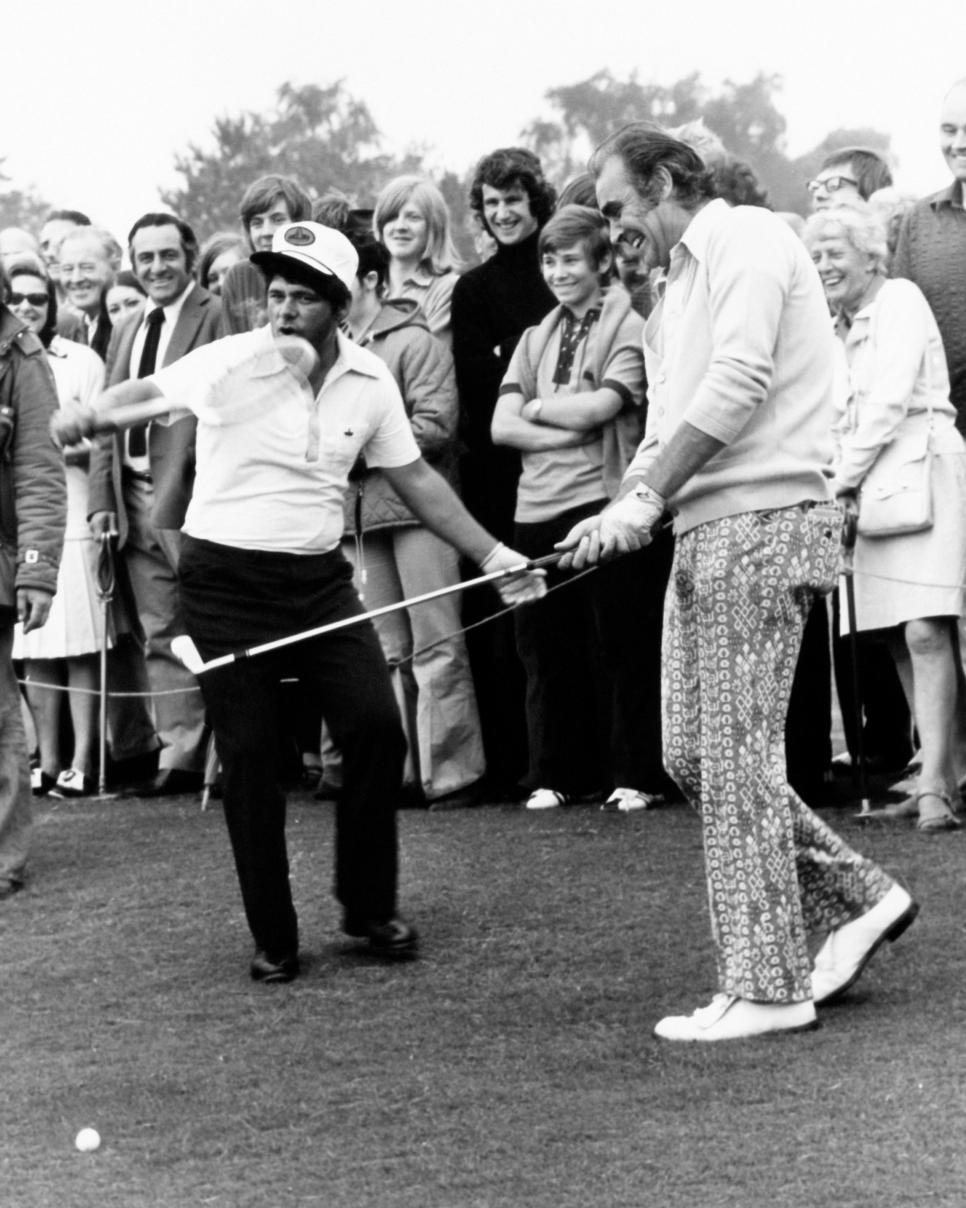David Cannon
Sean Connery hits a shot during the 2002 Laureus Golf Challenge at the Monte Carlo Golf Club at Mont Agel in Monaco.
By John Huggan
Right at the end of “Chariots of Fire,” winner of the 1981 best movie Oscar, some text appears on the screen. Revealed is the brain tumour that caused the death of Christian missionary Eric Liddell, winner of the 400 meters gold medal at the 1924 Olympics in Paris, towards the end of World War II. “All of Scotland mourned,” was the last line.
That universally shared sense of loss was repeated on Saturday, when news of Sean Connery’s passing at the age of 90 was announced. The Edinburgh-born actor and golf fanatic is best remembered as the man who first played secret agent 007, James Bond, in the still-running series of movies. He was also Indiana Jones’ Dad in “The Last Crusade.” But it was his role as a Chicago cop of Irish ancestry in “The Untouchables” that earned Connery his only Oscar in 1988.
All of which is a long way from an impecunious upbringing in the Fountainbridge area of “Auld Reekie,” the nickname of Scotland’s capital city. After a stint as a milkman, the young Connery joined the Royal Navy at 16, only to be invalided out two years later with stomach ulcers. Thereafter he was employed in various roles, one a coffin polisher in the East Lothian town of Haddington. It was there, after evenings out at the local dance hall, that Connery would sleep in one of the coffins if he missed the last bus back to Edinburgh.
Still, it was as Bond that the former Mister Universe contestant—and sometimes nude model for artists—appeared in the most-iconic golf scene in cinematic history. Filmed at the Harry Colt-designed Stoke Poges (now Stoke Park) north of London, Connery famously tricked the cheating Gert Frobe as Auric Goldfinger during a match that started as a “shilling a hole” contest, but ended a fractious battle for a bar of gold bullion.
That film‑and the lessons he took to prepare for the role‑was the start of Connery’s passion for golf. Not surprisingly, the tribute from the current Bond, Daniel Craig, contained a reference to the game. “My thoughts are with his family and loved ones,” wrote Craig. “Wherever he is I hope there is a golf course.”

Chris Ware
In his London home, Sean Connery prepares his clubs for play in 1962.
Given his global status, Connery was a genuine hero in his homeland. Despite living for many years in the Bahamas, “Big Tam,” as he was always known to his oldest friends (Sean was Connery’s middle name), was a lifelong and very public advocate of Scotland gaining independence from the United Kingdom. One of the two tattoos adorning his arms reads “Scotland Forever.” That support, many felt, delayed the knighthood Connery belatedly received from Queen Elizabeth in 2000.
A member of the R&A and a regular competitor in club events at St. Andrews, Connery was reputedly more than careful with his money and never one to suffer fools gladly. But the fierceness that led to many fistfights—a dispute over whether or not Connery was having an affair with co-star Lana Turner ended with Connery punching out Turner’s boyfriend, Mafia gangster Johnny Stompanato—made Connery a zealous competitor on the golf course. Legend has it that another altercation, this time with a fellow golfer at County Sligo in Ireland, ended with said golfer unconscious.

Peter Dazeley
Sean Connery and Lee Trevino shares laugh during the filming of the television program, “Master Golf,” at Walton Heath Golf Club in 1972.
It was his obvious and well-documented enthusiasm for the game that led Golf Digest to pursue Connery for interview on multiple occasions. But even the promise of a position on the cover of the game’s most popular magazine was not enough to tempt 007. Long-time Golf Digest editor Jerry Tarde did once receive a phone call from Connery in the wake of a mutual friend’s death, but when the conversation shifted to the possibility of that interview, Tarde was again unsuccessful. “He shot me down the way James Bond dispatched villains,” Tarde said.
One last attempt was made. Thinking Connery might be tempted to converse with one of his compatriots, I wrote to the great man at his home in the Bahamas. Boy, did I lay it on thick, even mentioning the fact that I was born in Haddington, his old stomping ground.
All to no avail, although Connery did have the courtesy to call me back with the bad news. Which is not to say I thought it was him. Not at first. As just about every Scot has had a go at reproducing Sean’s distinctive brogue, I initially thought it was a friend whose propensity for imitation is especially pronounced. The conversation went something like this:
“Aye right Dave, pull the other one.”
“No, itsh me.”
“Yeah, yeah. I’m not falling for it.”
“No, no, it really ish me [laughing].”
“Oh my God, it is you.”
It was, it goes without saying, a privilege to speak to the man who was, at the time and by a distance, the most famous living Scot. He was perfectly polite. But he was also disappointingly firm. It didn’t matter that we shared an accent. It didn’t matter that all I wanted to talk to him about was golf.
“I’m retired,” he said. “And done with that sort of thing.”
So I‑and Golf Digest‑never did get an interview with Sean Connery. It remains the biggest disappointment of my journalistic career. RIP big man.









